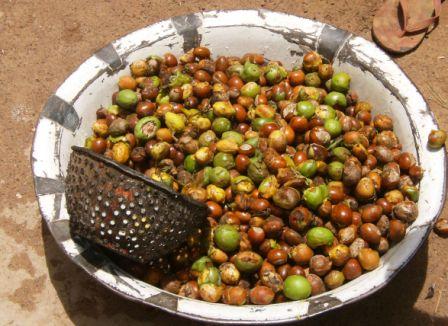The Day of a Shea Woman Collector
Picking the nuts
At 5 am, the woman leaves her house carrying an empty basin on her head, and walks to the bush, at least 1 mile away from the village). She then starts picking the nuts that have fallen on the floor and de-pulp some before putting them in her basin. She will go from tree to tree until her basin is full.

Shea nuts hanging on the tree. If they are ready, they fall of the tree and can be colected.
Challenging enviornment
One could think that shea nuts picking is as fun as apple picking and that there is no risk behind it...Unfortunately, it is not the case. Snakes and scorpions are in the bush and can bite the picker's leg or arm when she extends it to reach for the nuts. And when the rain starts pouring, the woman will stay under the rain with no raincoat until she is finished picking. So you can imagine how soaked they are when they get home....the sneezing and cold is then not far...

Basin full of shea nuts, most of them have been de-pulped already (brown coloured).
Processing the nuts
Around 8:30 am, she is back at home and needs to get down to her household obligations (cooking, cleaning, etc.). When she has time free again, she will de-pulp the nuts further and boil them (in their shell) in a big cooking pot.

Women over the fire, stirring her cooking pot
She will then spread out the wet nuts over her swept floor to let them dry at the sun. The drying process can last up to two weeks depending on the weather conditions. If there is not enough sun or if it rains over the nuts, their will be a higher risk of the nuts to get spoiled.
Once the nuts are well dried, she will crack the shells with a stone, decorticate them and dry the kernel for storage or immediate sell.
Most women in Northern Ghana are involved in shea picking & processing between April & July. But this is one among the many daily activities of the women throughout the year. They spend the greater portion of their time obtaining water for domestic needs, collecting or buying woods, cooking and processing food such as groundnut oil, and helping their husband at the farm. I hope that this introduction to the life of our target group will have contributed in a better comprehension of those women's challenges.
